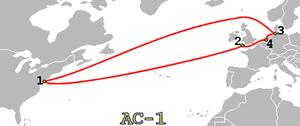
Telegraphy is the long-distance transmission of messages where the sender uses symbolic codes, known to the recipient, rather than a physical exchange of an object bearing the message. Thus flag semaphore is a method of telegraphy, whereas pigeon post is not. Ancient signalling systems, although sometimes quite extensive and sophisticated as in China, were generally not capable of transmitting arbitrary text messages. Possible messages were fixed and predetermined, so such systems are thus not true telegraphs.
Communications in the United States include extensive industries and distribution networks in print and telecommunication. The primary telecom regulator of communications in the United States is the Federal Communications Commission.
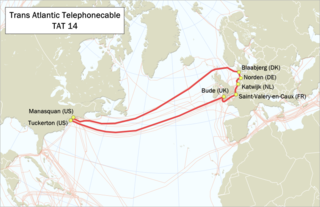
TAT-14 was the 14th consortium transatlantic telecommunications cable system. In operation from 2001 to 2020, it used wavelength division multiplexing. The cable system was built from multiple pairs of fibres—one fibre in each pair was used for data carried in one direction and the other in the opposite direction. Although optical fibre can be used in both directions simultaneously, for reliability it is better not to require splitting equipment at the end of the individual fibre to separate transmit and receive signals—hence a fibre pair is used. TAT-14 used four pairs of fibres—two pairs as active and two as backup. Each fibre in each pair carried 16 wavelengths in one direction, and each wavelength carried up to an STM-256. The fibres were bundled into submarine cables connecting the United States and the European Union in a ring topology.
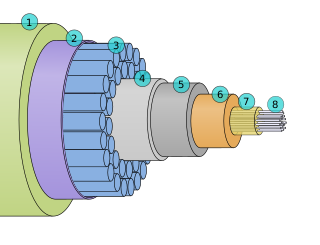
A submarine communications cable is a cable laid on the seabed between land-based stations to carry telecommunication signals across stretches of ocean and sea. The first submarine communications cables were laid beginning in the 1850s and carried telegraphy traffic, establishing the first instant telecommunications links between continents, such as the first transatlantic telegraph cable which became operational on 16 August 1858.
Global Crossing Limited, was a telecommunications company that provided computer networking services and operated a tier 1 carrier. It maintained a large backbone network and offered peering, virtual private networks, leased lines, audio and video conferencing, long-distance telephone, managed services, dialup, colocation centres and VoIP. Its customer base ranged from individuals to large enterprises and other carriers, with emphasis on higher-margin layered services such as managed services and VoIP with leased lines. Its core network delivered services to more than 700 cities in more than 70 countries.
Communications in Barbados refers to the telephony, internet, postal, radio, and television systems of Barbados. Barbados has long been an informational and communications centre in the Caribbean region. Electricity coverage throughout Barbados is good and reliable. Usage is high and provided by a service monopoly, Barbados Light & Power Company Ltd..
Transatlantic crossings are passages of passengers and cargo across the Atlantic Ocean between Europe or Africa and the Americas. The majority of passenger traffic is across the North Atlantic between Western Europe and North America. Centuries after the dwindling of sporadic Viking trade with Markland, a regular and lasting transatlantic trade route was established in 1566 with the Spanish West Indies fleets, following the voyages of Christopher Columbus.

A transmission tower is a tall structure, usually a lattice tower made of steel that is used to support an overhead power line. In electrical grids, transmission towers carry high-voltage transmission lines that transport bulk electric power from generating stations to electrical substations, from which electricity is delivered to end consumers; moreover, utility poles are used to support lower-voltage sub-transmission and distribution lines that transport electricity from substations to electricity customers.
Cogeco Inc. is a Canadian telecommunications and media company. Its corporate offices are located at 1 Place Ville-Marie in Montreal, Quebec. The company is structured into three strategic business units (SBU); Cogeco Connexion, Breezeline, and Cogeco Media. The company provides a range of telecommunication products and services including cable television, radio and television broadcasting, telephony, and Internet services in Ontario and Quebec in Canada, and in eleven states along the east coast of the United States.

Cable & Wireless plc was a British telecommunications company. In the mid-1980s, it became the first company in the UK to offer an alternative telephone service to British Telecom. The company later offered cable TV to its customers, but it sold its cable assets to NTL in 2000. It remained a significant player in the UK telecoms market and in certain overseas markets, especially in the former British colonies of the Caribbean, where it was formerly the monopoly incumbent. It was also the main supplier of communication in the British South Atlantic, including Saint Helena and the Falkland Islands. It was listed on the London Stock Exchange and was a constituent of the FTSE 100 Index.

A cable layer or cable ship is a deep-sea vessel designed and used to lay underwater cables for telecommunications, for electric power transmission, military, or other purposes. Cable ships are distinguished by large cable sheaves for guiding cable over bow or stern or both. Bow sheaves, some very large, were characteristic of all cable ships in the past, but newer ships are tending toward having stern sheaves only, as seen in the photo of CS Cable Innovator at the Port of Astoria on this page. The names of cable ships are often preceded by "C.S." as in CS Long Lines.
Level 3 Communications was an American multinational telecommunications and Internet service provider company headquartered in Broomfield, Colorado. It ultimately became a part of CenturyLink, where Level 3 President and CEO Jeff Storey was installed as Chief Operating Officer, becoming CEO of CenturyLink one year later in a prearranged succession plan.
Fibre-optic Link Around the Globe (FLAG) is a 28,000-kilometre-long fibre optic mostly-submarine communications cable that connects the United Kingdom, Japan, India, and many places in between. The cable is operated by Global Cloud Xchange, a subsidiary of RCOM. The system runs from the eastern coast of North America to Japan. Its Europe–Asia segment was the fourth longest cable in the world in 2008.
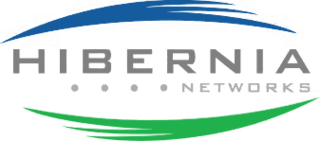
Hibernia Networks, alternately known as Hibernia Atlantic, was a privately held, US-owned provider of telecommunication services. It operated global network routes on self-healing rings in North America, Europe and Asia including submarine communications cable systems in the North Atlantic Ocean which connected Canada, the United States, the Republic of Ireland, the United Kingdom and mainland Europe. Hibernia managed cable landing stations in Dublin, Republic of Ireland; Coleraine, Northern Ireland; Southport, England; Halifax, Canada; Lynn, Massachusetts, United States.
Apollo is an optical submarine communications cable system crossing the Atlantic Ocean, owned by Apollo Submarine Cable System Ltd. It consists of 2 segments North and South, creating two fully diverse transatlantic paths.

Yellow / AC-2 is a submarine telecommunications cable system linking the United States and the United Kingdom. The cable is wholly owned by CenturyLink in the US following its acquisition of Global Crossing. The original owners, which each owned two of the fibre pairs, gave this cable system different names, so it is known as both Yellow and AC-2. It has a capacity of 320 Gbit/s as of January 2007, upgradeable to 640 Gbit/s.

Breezeline is the trade name for the United States operations of Cogeco Communications, constituting the 8th largest cable operator in the United States, based on the number of television service customers served. The company currently provides TV, Internet and phone services using a combined coaxial cable & fiber-to-the-premises (FTTP) network. Breezeline currently has approximately 707,000 broadband customers located in twelve states: New Hampshire, Maine, Connecticut, New York, Pennsylvania, Delaware, Maryland, Ohio, West Virginia, Virginia, South Carolina, and Florida. The company is headquartered in Quincy, Massachusetts.
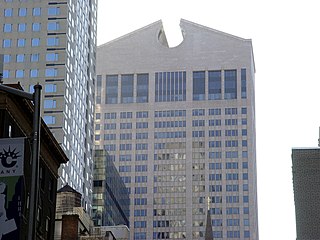
AT&T Corporation, commonly referred to as AT&T, an abbreviation for its former name, the American Telephone and Telegraph Company, was an American telecommunications company that provided voice, video, data, and Internet telecommunications and professional services to businesses, consumers, and government agencies.
The Critical Foreign Dependencies Initiative (CFDI) is a strategy and list, maintained by the United States Department of Homeland Security, of foreign infrastructure which "if attacked or destroyed would critically impact the U.S." A copy of the 2008 list was redacted and leaked by WikiLeaks on 5 December 2010 as part of the website's leak of US diplomatic cables; no details on the exact location of the assets was included in the list. In September 2011, WikiLeaks published the unredacted copy of the list. The list's release was met with strong criticism from the US and British governments, while media and other countries have reacted less strongly saying that the entries are not secret and easily identified.
